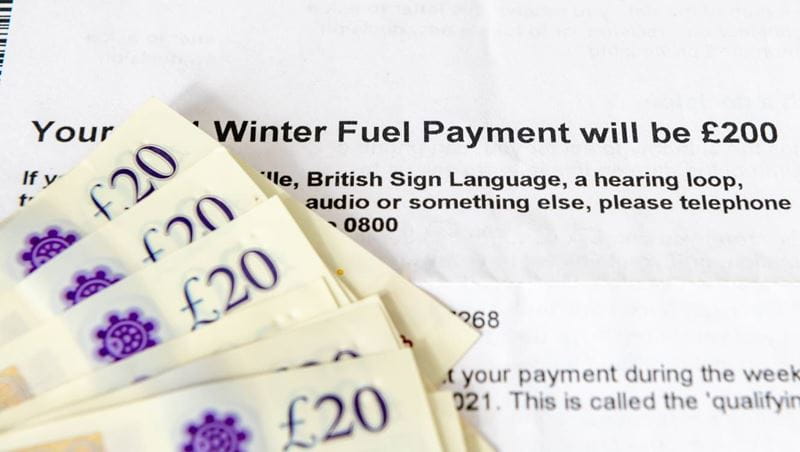

This article is for general guidance only and is not financial or professional advice. Any links are for your own information, and do not constitute any form of recommendation by Saga. You should not solely rely on this information to make any decisions, and consider seeking independent professional advice. All figures and information in this article are correct at the time of publishing, but laws, entitlements, tax treatments and allowances may change in the future.
There has been a lot of uncertainty over the winter fuel payment, and people are being urged to be wary of new scams trying to take advantage of the confusion.
Last winter, the government restricted the winter fuel payment in England and Wales so only those receiving pension credit or other benefits were eligible. After widespread criticism, this winter more people will get the payment, compared to last year. But for the first time, anyone with income over £35,000 will need to pay the money back via the tax system.
There has been a surge in scams in recent weeks, ahead of next month’s payments. Below, we explain what you need to know.
On this page:
The winter fuel payment is a tax-free lump sum of between £100 and £300 paid each year to most people over state pension age (for this winter, that means born before 22 September 1959) who live in England or Wales. The idea is the cash helps with heating bills during the colder months, although you can spend the money as you wish.
The energy price cap rose by 2% on 1 October, meaning higher bills for most people. We don’t yet know what the price cap will be from 1 January 2026 – it will be revealed in late November – but it could be higher still.
Scammers are using the uncertainty around the winter fuel payment as a means of targeting those in later life. They are using various scam methods to trick people into handing over sensitive or personal information. The last week in September saw a 153% rise in reported spam text messages claiming to be from HMRC.
Winter fuel payments are made automatically, and the government will never ask for bank details by text. If you get a text message inviting you to apply for a payment, don't reply or click on any links. Instead, forward it to 7726. This will allow your network provider to investigate and potentially block the number.
Work and pensions secretary Pat McFadden said: “If you get a text message about winter fuel payments, it’s a scam. They will be made automatically so you do not need to apply. These despicable attempts by criminals to target people are on the rise.”
MoneySavingExpert warned its energy experts had come across several variants of the scam, with text messages purporting to be from the DWP, non-existent Department of Pensions or the non-existent ‘Department of Energy’.
As part of the phishing scam, victims are told they are eligible for a payment but must register by a certain date either by text or by clicking a link within the text or email. The link goes to a fake website that is designed to steal personal and financial information.
Independent Age Chief Executive Joanna Elson CBE said: "The key message is clear: you do not need to do anything to receive your Winter Fuel Payment. If you are eligible, it will be paid automatically."
Exactly how much winter fuel payment you receive depends on your circumstances in the ‘qualifying week’ of 15-21 September 2025. Payments for couples are usually split – for example, £100 each for a couple who are both aged under 80.
If you are eligible, you should get a letter in October or November that tells you how much you will get. The winter 2025/26 payment is due to be paid around the second half of November.
When it was introduced in 1997, the winter fuel payment was available automatically to everyone of state pension age or older. But in July 2024, the government announced that from winter 2024/25, only those getting pension credit or equivalent means-tested benefits would be entitled to the cash. The move drew widespread criticism, with activist groups and unions pursuing legal challenges and calling for the policy to be reversed.
New figures released by the Department for Work and Pensions (DWP) in September showed the numbers receiving the winter fuel payment last winter dropped to just 1.3 million – down from 10.6 million the year before.
The chancellor, Rachel Reeves, announced a U-turn in June 2025, with certain limits. She confirmed that from winter 2025/26 onwards, all pensioners would receive the winter fuel payment. But those with taxable income over £35,000 would then have to pay it back. If there’s two of you in the household, and only one person earns over £35,000, that person will have to pay back their share. Around 9 million pensioners are expected to receive it this winter.
Remember to apply for pension credit if you think you are eligible. It doesn’t just top up weekly income – it also unlocks a host of other benefits such as council tax and rent support and a free TV licence. You can backdate your claim for pension credit by up to three months.
Sarah Coles, personal finance expert at investment platform Hargreaves Lansdown, says if you don’t opt out of the winter fuel payment, and your taxable income is over £35,000, you’ll have to pay it back.
How this will happen depends on how you pay tax:
“Neither option is the end of the world, but could come as a nasty surprise if your pension arrives in your bank account and is smaller than you were expecting because your tax bill has changed,” Coles adds.
If you’re not sure whether your payment will be taken back, HMRC has provided an online calculator to help you work it out.

The winter fuel payment is a devolved matter in Scotland and Northern Ireland. This means the Scottish government and Northern Ireland executive have set their own policies.
The payment and eligibility rules in Northern Ireland are the same as for England and Wales.
In Scotland the rules are very similar, but it's called the pension age winter heating payment. This is worth £203.40 per household, or £305.10 if someone in the household is over 80. Payments will also be clawed back by HMRC if you earn more than £35,000.
The threshold refers to your gross annual income – everything you earn before tax.
This includes:
It does not include tax-free income from Premium Bond prizes, ISAs, lodger income under the Rent a Room scheme, pension credit, attendance allowance and other tax-free state benefits.
Yes, it’s worth making sure you are taking advantage of allowances available to you.
The £35,000 threshold is based on your taxable income, rather than your total income. By lowering your taxable income, you might be able to qualify for the winter fuel payment, and save on tax too.
One of the first things you should do is ensure you’re making the most of ISAs.
Andy Wood, adviser at tax network Tax Natives, says: “Many pensioners may not realise that interest earned on savings held outside of ISAs count towards their total taxable income. With interest rates still relatively high, even modest savings can generate income that pushes someone over the threshold.”
You should also have a look at how you take pension income. The first 25% taken as tax-free cash from a defined contribution pension is not taxable income. But any further withdrawals from pensions, such as via an annuity, income drawdown or a lump sum is taxable.
If you’re still working, then paying into your pension via salary sacrifice, if your employer allows that, will also reduce your gross income since the pension contributions are taken from your salary before you receive it.
If you have significant savings in ISAs, you could also consider taking income from those pots ahead of your pension. This would reduce your taxable income, without reducing your overall income.
Another tactic is to defer taking your state pension if you can manage without it. Even if you have started taking your pension you can still defer it – but note you can only do this once.
Wood says: “Deferring your state pension is an option. However, it’s worth saying that deferring it means you will get a larger state pension when you do come to claim it, and this has the potential to push you up into higher tax bands or mean you no longer qualify for benefits you would have otherwise received.
“You also have to weigh up whether it’s worth losing out on a year’s worth of state pension now in order to claim the winter fuel allowance plus a higher state pension later.”
For many people with income over £35,000 a year, it might seem simpler to opt out of receiving the payment rather than receive it and pay it back.
The deadline to opt-out for this winter's payment (2025/26) was 14 September in England, Wales and Northern Ireland. If you didn't opt out, you will receive the payment automatically and it will be reclaimed via the tax system if you are over the income threshold. It’s likely that you’ll be able to opt out of the following winter’s payment, but you can’t do that yet.
If you live in Scotland, you can no longer opt out online, but you may still be able to opt out by calling 0800 182 2222. There is no set deadline for people to opt out. The Scottish government says: “If you choose to opt out after we've made a decision on your payment, you'll still receive a payment for this year. In this case, you’ll not get the payment from winter 2026-2027 onwards.”
If you want to opt in again – for example, if your income changes – you can do so by calling the helpline.
To get a payment for winter 2026/7 you’d need to opt in again before 31 March 2026.
Caroline Abrahams, charity director at Age UK, says: “Opting out is a matter for each person to decide. The cost of heating your home through the cold months can be high, so some people on incomes over £35,000 may prefer to receive the payment and then settle up with the government later, while others may prefer just to opt out now and not worry about it again.”

/mature-couple-looking-at-taxes.jpg?la=en&h=650&w=1400&hash=5CFABEEDC751F26D56DD3E85749E3C36)

Understand how your money is taxed in retirement and learn simple ways to reduce your bill.


Find out how to trace lost bonds and claim your money

Find out the different types, the pros and cons, and how much income you might get.